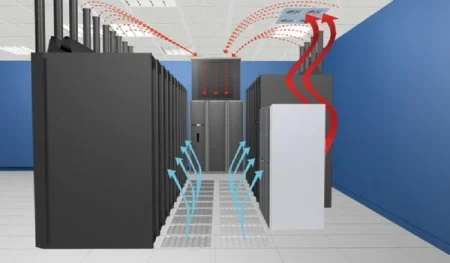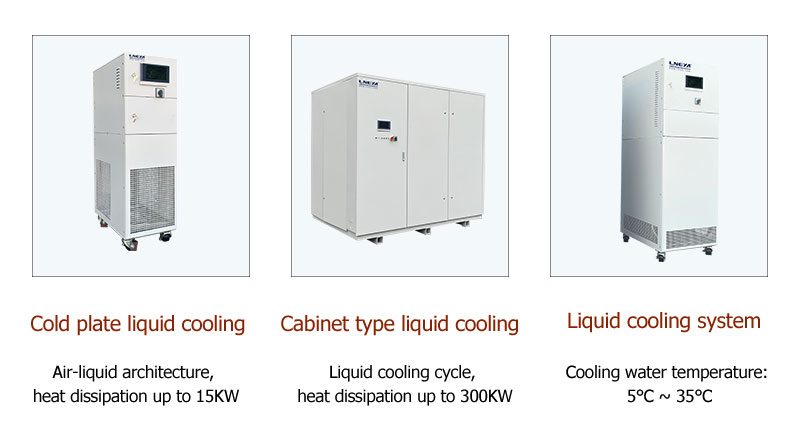Free Cooling Data Center
Kontaktieren Sie uns noch heute für die perfekte Lösung zur Temperaturkontrolle
The data center contains servers, communication equipment, cooling and power supply equipment, etc., and is the center of data processing. PUE is an indicator for evaluating the energy efficiency of a data center. It is the ratio of all energy consumed by the data center to the energy used by the IT load. The benchmark is 2, with closer to 1 indicating a better level of energy efficiency.
The energy consumption of data centers is mainly concentrated on servers and air conditioning systems. Reducing the energy consumption of air conditioning systems has an important impact on improving energy utilization in data centers. Due to the high energy consumption of the conventional cooling technology system and the low energy utilization rate of the computer room, the PUE remains high. In recent years, researchers have proposed new cooling methods that use natural cold sources to cool data centers. Natural cooling technology can use natural cold air or low-temperature water sources to cool the data equipment room, which has obvious energy-saving effects. It mainly includes wind side natural cooling, water side natural cooling and heat pipe natural cooling.

1. Wind side natural cooling technology
Wind-side natural cooling uses outdoor cold air to cool the data center. In the system, sensors are set up to monitor indoor and outdoor temperatures. When conditions are suitable, outdoor cold air is directly introduced into the room or utilized. Wind side natural cooling technology is a technology with great application prospects. This technology is mainly divided into three categories: direct wind side natural cooling, indirect wind side natural cooling and evaporative cooling.
a. Direct wind side natural cooling technology
Direct air side free cooling technology is a technology that directly introduces outdoor cold air into the data center for cooling. Direct wind side natural cooling technology has been applied in some areas and achieved good results.
Direct wind side natural cooling technology has certain requirements for regional air quality, and it needs to be improved in some areas. Some people have conducted research on the application of natural cooling technology in data centers in severe cold and dusty areas. The application of intelligent heat exchange and energy-saving technology in air ducts can effectively solve the problem of air cleanliness caused by fresh air.
The direct air side natural cooling system is the simplest and clearest natural cooling method, with the characteristics of low investment and high return. However, this technology also has certain limitations. The direct introduction of outdoor air will lead to uneven indoor humidity distribution and fine particulate matter. Due to problems such as the introduction of pollutants and the introduction of pollutants, filters need to be used to filter the fresh air, which will lead to increased maintenance costs for the equipment. Therefore, when using this technology, local air quality and climate conditions must be fully considered.
b. Indirect wind side natural cooling technology
Unlike the direct air side natural cooling technology that directly introduces fresh air, the indirect air side natural cooling technology utilizes outdoor cold air through a heat exchanger. Indirect air cooling utilizes outdoor cold air through heat exchangers to ensure that the data center is not disturbed by the external environment.
The indirect air side natural cooling system has a good energy saving effect and is a technology with great potential. However, due to the large size of the system’s equipment, its application scope is limited. Likewise, as air passes through a heat exchanger, contaminants and particulate matter can accumulate on the exchanger over time, which can cause the heat exchanger to become less efficient and increase maintenance costs. Therefore, the system currently has few applications.
c. Evaporative cooling technology
Evaporative cooling technology is a technology that uses the principle of water evaporation cooling to obtain cold air through direct evaporation or indirect evaporation. According to the different evaporation methods, it is divided into direct evaporative cooling technology and indirect evaporative cooling technology. Direct evaporative cooling technology has the advantages of large air volume, small temperature difference, and good humidification effect in winter. Indirect evaporative cooling technology has the advantages of high efficiency and not easy to block.
Evaporative cooling technology can isolate the indoor and outdoor environments, ensuring that the internal environment of the computer room is not disturbed, and has a good effect on improving the stability of equipment operation. However, there are still some problems that need to be solved urgently, such as local hot spots and indoor humidity control, which need to be further studied and solved.

2. Water side natural cooling technology
Water-side natural cooling technology refers to a facility that directly uses natural cold sources to pass through cooling water, thereby ensuring that the internal environment is not affected during the cooling process. Water-side natural cooling technology is mainly divided into two types: direct type and cooling tower type.
In the direct water-cooled natural cooling system, natural low-temperature water is directly introduced into the data center for cooling without any heat exchange process. Direct water-cooled natural cooling has better energy-saving effects, but this technology is highly dependent on natural cooling sources. Therefore, data centers are often located close to lakes and seas. This makes the application of this technology have certain limitations, and there are currently few direct applications.
Cooling tower technology refers to the technology that uses natural cold sources to produce low-temperature water through cooling towers to cool the data center. This technology is one of the most widely used free cooling technologies in data centers.
This technology is a better natural cooling solution when the outdoor wet-bulb temperature is low. However, when using this technology, the cold water temperature must be strictly monitored, and antifreeze measures must be taken in severely cold areas.
3. Heat pipe natural cooling technology
Heat pipe cooling technology refers to a natural cooling technology that transfers outdoor cold energy through heat pipes. This technology has strong temperature control performance and can conduct heat transfer under small temperature differences. Compared with traditional air conditioning systems, heat pipe technology has better air flow organization, which greatly reduces the existence of local hot spots. Since the natural cooling of heat pipes will not affect indoor air quality and humidity, it can better utilize natural cold sources and achieve better heat transfer effects. Therefore, in recent years, heat pipe natural cooling technology has attracted more and more attention from domestic and foreign scholars. Heat pipe natural cooling systems can be divided into three types: separated type, composite type and cold storage type.
The separated heat pipe system can directly cool the data center without the need for mechanical refrigeration, but when the ambient temperature is high, a vapor compression system is required for auxiliary cooling.
The composite heat pipe system combines the separate heat pipe unit and the vapor compression refrigeration unit into a whole through the evaporative condenser, which reduces the initial investment to a certain extent.
Ambient temperature has a great impact on the cooling capacity of the heat pipe system, which also has a certain impact on its stability and reliability. In order to overcome these shortcomings, the cold storage heat pipe system combines traditional heat pipes with cold storage devices to increase the rationality of utilizing natural cold sources to a certain extent.
4. Limitations of natural cooling technology
The application of free cooling technology can reduce the energy consumption of data centers, but it also has certain limitations. As for the wind-side natural cooling technology, although the direct type has good energy-saving effect, it cannot avoid the harm of outdoor air pollution to the equipment, and it is difficult to control the indoor temperature and humidity. Therefore it must be used in areas with suitable climate conditions. Since the runner is expensive, has limited efficiency, and is bulky, the initial investment of the indirect wind-side natural cooling system is high, so there are few engineering examples. The air is humidified during evaporative cooling, so the temperature and humidity in the computer room cannot be well controlled, and the power loss caused by water consumption will also increase the PUE.
For water-side natural cooling technology, direct water-side natural cooling has strict location requirements. The impact of wastewater on local water quality and ecological environment should also be considered during design. Although the cooling tower natural cooling system is currently the most widely used technology , but the value of the natural cooling conversion temperature has not yet reached a consistent conclusion, so there are often large differences in the calculation results. In severe cold and cold areas, the cooling tower must be equipped with reliable anti-freeze technical measures, including alarms, controls and Necessary emergency heating and antifreeze measures.
In future research, in order for heat pipe natural cooling technology to achieve better energy-saving effects in practical applications, it is necessary to further consider the distribution and leakage of refrigerant, cooling capacity attenuation, outdoor unit connecting pipes and height differences, mechanical refrigeration and air conditioning Problems such as coordination between the unit and the heat pipe air conditioning unit. In addition, the investment, operation, and maintenance costs of the free cooling system are also issues that must be considered during the life cycle of the data center.
| Modell | ZLFQ-15 | ZLFQ-25 | ZLFQ-50 | ZLFQ-75 | ZLFQ-100 | ZLFQ-150 |
| Temperaturbereich | +5℃~35℃ | +5℃~35℃ | +5℃~35℃ | +5℃~35℃ | +5℃~35℃ | +5℃~35℃ |
| Kühlwasser | 5℃~30℃ Einsatz eines Siemens/Honeywell-Regelventils zur Steuerung des Kühlwasserflusses | |||||
| Genauigkeit der Temperaturregelung | ±0.2℃ | ±0.5℃ | ±0.5℃ | ±0.5℃ | ±0.5℃ | ±0.5℃ |
| Flusskontrolle | 10~25L/min | 25~50L/min | 40~110L/min | 70~150L/min | 150~250L/min | 200~400L/min |
| Die Durchflussregelung wird über einen Frequenzumrichter eingestellt, die Genauigkeit beträgt ±0,3 l/min. | ||||||
| Kühlleistung (MAX) | 15kW | 25kW | 50kW | 75kW | 100kW | 150kW |
| Speichervolumen | 15L | 30L | 60L | 100L | 150L | 200L |
| Sole | Wasser, Silikonöl, fluorierte Flüssigkeit, wässrige Ethylenglykol-Lösung, usw. | |||||
| Mittlere Rohrleitung | SUS304 | SUS304 | SUS304 | SUS304 | SUS304 | SUS304 |
| Größe der Eingangs- und Ausgangsschnittstelle | G3/4 | G1 | G1 | DN32 | DN40 | DN50 |
| Schnittstelle zum Kühlwasser | G3/4 | G1 | DN40 | DN50 | DN50 | DN65 |
| Kühlwasserdurchfluss 7~20℃ | 2.5m³/h | 4m³/h | 8m³/h | 13m³/h | 17m³/h | 25m³/h |
| 380V 50HZ | 1kW | 1,5 kW | 3kW | 4kW | 5kW | 6kW |
| Shell | Kaltgewalztes Blech Spray RAL7035 | |||||
| Modell | ZLFQ-200 | ZLFQ-250 | ZLFQ-300 | ZLFQ-400 | ZLFQ-500 |
| Temperaturbereich | +5℃~35℃ | ||||
| Temperaturgenauigkeit | ±0.5℃ | ||||
| Durchflusskontrolle | 15~30m³/h | 20~35m³/h | 25~40m³/h | 30~60m³/h | 40~70m³/h |
| Kühlleistung(MAX) | 200kW | 250kW | 300kW | 400kW | 500kW |
| Speichervolumen | 250L | 300L | 600L | 1000L | 1200L |
| Mittel | Wasser, Silikonöl, fluorierte Flüssigkeit, wässrige Ethylenglykol-Lösung, usw. | ||||
| Mittlere Rohrleitung | SUS304 | ||||
| Größe der Eingangs- und Ausgangsschnittstelle | DN65 | DN65 | DN65 | DN80 | DN80 |
| Schnittstelle zum Kühlwasser | DN80 | DN80 | DN100 | DN100 | DN125 |
| Kühlwasserdurchfluss 7~20℃ | 34m³/h | 43m³/h | 51m³/h | 69m³/h | 86m³/h |
| Stromversorgung 380V 50HZ | 7kW | 7kW | 8kW | 9kW | 13kW |
| Shell | Kaltgewalztes Blech Spray RAL7035 | ||||

Wir bieten die Entwicklung und Herstellung kompletter Temperaturkontrollsysteme an. Von Standardmodellen bis zu kompletten kundenspezifischen Produkten bis hin zu 1000 Tonnen. Wir haben uns auf den Kundenservice spezialisiert und sind bestrebt, jedem Kunden zu helfen, das optimale Temperaturkontrollsystem für seinen spezifischen Bedarf zu finden.
Wir bieten maßgeschneiderte Lösungen, die nicht dem Standard entsprechen.
E-Mail: lilia@lneya.com WeChat ID: +8615251628237 WhatsApp: +86 17851209193

 LNEYA
LNEYA
 简体中文
简体中文

















































































